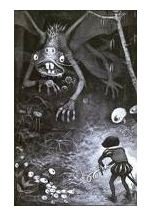Using Context Clues to Figure the Meaning of Nonsense Words: The Jabberwocky & Other Ideas
If you’re students are starting to get finger sprain and paper cuts from looking up words in heavy dictionaries, it’s time for you to teach them how to decipher word meanings based on context clues. Try this lesson on deciphering the meaning of nonsense words using nothing but context.
The Lesson
One of the problems in assessing how well students use context clues to decide word meaning is to know whether they already know the word’s meaning. That’s why nonsense words are useful.
Procedures
- If needed, review the different types of context clues and strategies for unlocking word meanings.
- Recreate a passage from a literary work (one that’s in the public domain, so you can just copy and paste).
- Replace words in the text with nonsense words and number them (There’s an example below).
- Instruct students to define the nonsense words by the context. This can be done as an individual or group practice activity or as an assessment.
- Options include creating nonsense words from common foreign roots. This forces students to use different forms of context to determine word meaning, which is the ultimate goal of a vocabulary context clues lesson plan.
- By the way, don’t forget the parts of speech.
Sample Reading Passage
This passage comes from the “Most Dangerous Game” by Richard Connell (1924, Collier’s Weekly). Any passage will do.
Bleak darkness was blacking out the sea and jungle when Rainsford sighted the lights. He came upon them as he turned a crook in the coast line; and his first thought was that be had come upon a (1) skanaslok, for there were many lights. But as he forged along he saw to his great 2) herskimadoo that all the lights were in one enormous building–a 3) goonle structure with pointed towers plunging upward into the 4) nackwalm. His eyes made out the shadowy outlines of a palatial 5) kicknspur; it was set on a high bluff, and on three sides of it cliffs dived down to where the sea licked greedy lips in the shadows.
“Mirage,” thought Rainsford. But it was no 6) tingpert, he found, when he opened the tall spiked iron gate. The stone steps were real enough; the massive door with a leering 7) hankshank for a knocker was real enough; yet above it all hung an air of 8) hooshslendoo.
He lifted the knocker, and it 9) mankled up stiffly, as if it had never before been used. He let it fall, and it startled him with its booming loudness. He thought he heard steps within; the door remained closed. Again Rainsford lifted the heavy knocker, and let it fall. The door opened then–opened as suddenly as if it were on a spring–and Rainsford stood blinking in the river of glaring gold light that poured out. The first thing Rainsford’s eyes discerned was the largest man Rainsford had ever seen–a gigantic creature, solidly made and black bearded to the waist. In his hand the man held a long-barreled 10) hoklumb, and he was pointing it straight at Rainsford’s heart.
Key - This key has the replaced word. Student responses will differ.
(1) village; (2) astonishment; (3) lofty; (4) gloom; (5) chateau; (6) mirage; (7) gargoyle; (8) unreality; (9) creaked; (10) revolver
Another Reading Passage with Nonsense Words

Just in case you don’t feel like copying and pasting and replacing, Lewis Carroll’s done the work for you.
The Jabberwocky by Lewis Carroll (from Through the Looking-Glass and What Alice Found There, 1872)
-
`Twas brillig, and the slithy toves
-
Did gyre and gimble in the wabe:
-
All mimsy were the borogoves,
-
And the mome raths outgrabe.
-
“Beware the Jabberwock, my son!
-
The jaws that bite, the claws that catch!
-
Beware the Jubjub bird, and shun
-
The frumious Bandersnatch!”
-
He took his vorpal sword in hand:
-
Long time the manxome foe he sought –
-
So rested he by the Tumtum tree,
-
And stood awhile in thought.
-
And, as in uffish thought he stood,
-
The Jabberwock, with eyes of flame,
-
Came whiffling through the tulgey wood,
-
And burbled as it came!
-
One, two! One, two! And through and through
-
The vorpal blade went snicker-snack!
-
He left it dead, and with its head
-
He went galumphing back.
-
“And, has thou slain the Jabberwock?
-
Come to my arms, my beamish boy!
-
O frabjous day! Callooh! Callay!'
-
He chortled in his joy.
-
`Twas brillig, and the slithy toves
-
Did gyre and gimble in the wabe;
-
All mimsy were the borogoves,
-
And the mome raths outgrabe.
Ideas
Ideas for using “The Jabberwocky” for teaching context clues include the following:
- Create a multiple choice test with a definite correct answer.
- Create a multiple choice test with multiple correct answers.
- Create a short answer test, requiring justification for correct answers.
- Instruct students to write their own poem using 10 nonsense words.
- Create an advertisement selling tickets to a bandersnatch battle or an advertisement selling jubjub birds.
- Pretend the words in the poem are actual words and look on in astonishment as your students ask what they mean.
Whatever you choose to do with nonsense words, make sure the focus is on context reliance.
Public domain image courtesy of publicdomainclip-art.blogspot.com.
Jabberwocky: https://www.jabberwocky.com/carroll/jabber/jabberwocky.html
This post is part of the series: Mini-lessons to Improve Reading Skills
Emphasize skills with these reading skills mini-lessons.
